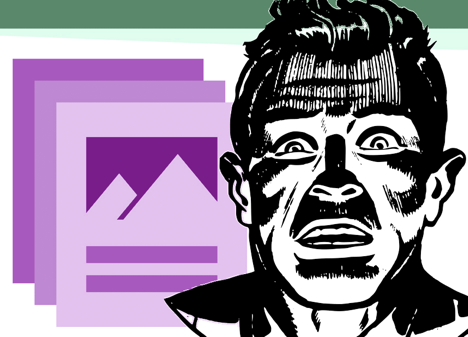My late father-in-law, an avid horse trader always said, “What goes around comes around.” I never knew what he meant, but then again much of what he said was like reading tea leaves: you saw what you wanted to see.
We are in the midst of progress and change that few generations have known. We’ve seen the old replaced by the new, and that new replaced by something even newer. We’ve seen revolutionary thinking give birth to whole new economic sectors, and we’ve witnessed new processes take the world by storm. If we pay attention however, we realize that in time those very processes often become their own worst enemy.
User-centered design is one such process. It makes so much sense, but if you are paying attention, you may notice that it’s in danger of becoming more of an obstacle than a solution. It is for this reason that I propose a new and different framework: Value-Centered Design.
Let’s raise the stakes
Although UX is a relatively young profession, standards and processes have rapidly evolved in recent years and user-centered design — while ubiquitous — is touted as some magical elixir. True, it is a very important component of a successful user experience design; but it is not comprehensive enough to sustain UX’s role as an equal business partner.
Simply put, user-centered design today is table stakes. It’s the bare minimum we should expect from any professional, so let’s quit patting ourselves on the back over it, and up those stakes right now.
A modest proposal
What if instead of elevating and analyzing users, we put them at the same level as the business, its product, and the pertinent strategic partners? What if we stated unequivocally that providing value is paramount to providing experiences that matter?
As UX professionals, we would need to shift our focus from being primarily advocates for the user, to being primarily advocates for value. We would need to understand what value is, then focus on delivering it at every step of the way.
So what is it?
We talk about providing value to our customers, but rarely do we discuss what it actually means. While sometimes tangible, value can be a slippery concept. Quite often, it’s an intangible yet perceived benefit; one which, when received in a fair exchange, deepens and cements relationships.
Further, what is valuable to one person may have no value at all to someone else. Our research and insights teams can help us distill raw data into actionable knowledge, but it is up to us to design experiences that deliver the right value to the right person at the right time.
What this means to you
Your mission, if you choose to accept it, is to begin thinking of ways you can facilitate a group process in which all digital touchpoints comprising the project are analyzed as potential value exchanges. You can still advocate for the user, but in addition to usability issues, you’re advocating for their received value. Furthermore, those users should feel content with what they have received; because in exchange they will happily provide what you want from them.
In other words, a value-centered design is one in which the objective is to offer something to your users that makes them feel good about giving something back. This ‘something’ doesn’t have to be a deep interactive experience, but just make it count; make it valuable… make it matter!
We’re starting from a solid foundation
User-centered design taught us to develop personas to personalize customer segments and to shift our perspective. It specified the creation of customer journey maps to illustrate that persona’s subjective states — from bare awareness to conversion, and ultimately brand loyalty.
While such persona and journey mapping is undoubtedly useful, it fails in telling us why we’re doing these things. More importantly, those artifacts and deliverables don’t provide specific guidance to the designers of a Website — even if that Website features dynamic, personalized content!
Value-centered design looks at a Website not as a single entity, but as an integrated system of touchpoints. Each of these touchpoints represents an interaction between your client’s organization and the public. Therefore, each one should provide something of value.
We need to maximize every available opportunity to deepen our client’s relationship with their customer. So think of touchpoints as single interactions or single chunks of content: a particular Web form, a video, an error routine, a pushed message, or email confirmation. Every touchpoint is an opportunity.
In return for the value provided, our clients receive a fair exchange: the value of their users’ attention. What to offer depends upon the individual’s perception of what is beneficial.
What do people want?
People are looking for value in the following five areas:
- Emotional
- Functional
- Social
- Learning
- Contextual
Emotional value
An individual who perceives an emotional experience to be of value seeks an experience that makes them feel connected. Whatever that connection is, we need to figure it out and maximize it.
Functional value
Functional value provides benefit to a person who wants to complete a transaction effortlessly. Maybe they’re looking up information or registering for something. It’s essential that there be no functional barrier to their transaction. Bonus points: add emotional depth by making the process enjoyable!
Social value
Social value pertains to our status among peers. How can we facilitate and enhance the social relevance and standing of our users?
Learning value
Learning value hardly needs to be explained. It offers a benefit for those who are curious. Let’s give them new doors to open and new ways to grow.
Contextual value
Finally, contextual value is a benefit that connects the virtual world with the real world by offering a benefit at a particular moment in a person’s life. Our experiences should provide value when it really matters, as the basis for enduring relationships.
All of these value exchanges happen through a system of touchpoints, represented by your digital footprint. Every piece of content on your client’s Website is a potential to offer not just one of the above five values, but combinations; every email you send, every Web form you display, and every message sent and received should be looked at through these five lenses.
That is the specific guidance offered by this framework, and that is why it’s powerful.
One size does not fit all
If you’ve followed me so far, you’re probably seeing that a value-centered methodology doesn’t negate user-centered design. It builds upon it and goes beyond by providing rich, multi-faceted guidance to the design team. It’s a framework that gives us concrete ways of interrogating our decisions and creative processes in a much less pedantic fashion; in other words not by simply enforcing the rules of a system that neglected to place business needs at the same level as those of the user.
By expanding your role to that of an advocate for value, you will begin seeing opportunities to design experiences that are cherished by your customers. In so doing, you will be far more likely to accomplish your clients’ most important business goals.
On the shoulders of giants
I am neither the inventor of value-centered design, nor the creator of the five types of value users seek mentioned earlier. I stumbled across the concept in a book called Mapping Experiences by Jim Kalbach. Kalbach credits Jess McMullin, who credits Lou Rosenfeld and Don Norman, among others. I credit all these authors (and many more).
Additionally, I credit the inspired professionals I work with. Not just UX professionals, but people from outside my field who have helped me understand the myriad considerations which must be taken into account when designing effective experiences.
Particular thanks goes to my anonymous colleague who recently told me, “We need to say, ‘Thank you’ about ten times more than we say, ‘Please’.”
That concise statement really drove home the need to provide value.
The lesson in all this is that we need to venture outside our comfort bubble. We need to lay down our established systems and look for fresh ways to solve new problems. Even the most successful paradigms should be challenged, for by so doing, we will not allow systems to limit us more than they propel us forward.
In the words of Albert Einstein, “We cannot solve our problems with the same thinking we used when we created them.”
And in the words of my late father-in-law, “What goes around, comes around.”



